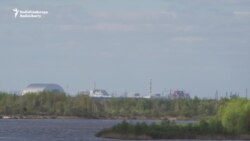Canadian scientist and leading Chernobyl researcher Dr. Timothy Mousseau says the potential for fresh catastrophe is hidden in the forests of the exclusion zone around the site of the world's worst nuclear accident.
Decades of extensive studies have led Mousseau to warn that a bolt from the blue, or the strike of a match, could lead to forest fires that send clouds of toxic, radioactive fallout spewing into the skies above Europe.
Two acts of suspected arson caused "large fires" in the 30-kilometer no-go zone around Chernobyl in the past year that burned long, fed by peat bogs, but "weren't particularly hazardous in terms of radioactivity," Mousseau says.
But he adds that "there was a third fire last year that made its way through part of the 'red forest,' which is the most contaminated part of the exclusion zone."
"It was relatively small, so they contained it fairly quickly, but it's the type of thing that has the potential to do serious harm if it had spread much more," Mousseau says. "The radioactivity that is contained in the woods would be put back up into the atmosphere, and depending on which way the wind was blowing, and whether it was raining or not, would be redeposited somewhere else."
His and other research into the accident at the Chernobyl Nuclear Power Plant that began on April 26, 1986, suggests that the toxic plume from a major fire could carry caesium-137, strontium-90, or iodine-131 across Europe, depending on which way the wind is blowing.
"If you look at the map of Europe from the original disaster, you'll get an idea of just how heterogeneous the deposition was," Mousseau says. "At the time of the accident, there was this huge fire for 10 days and the plume actually penetrated into the stratosphere, allowing radionuclides to be transported for thousands of miles."
The risk is compounded by the effects of a warming planet as well as the accumulation of dead leaves, fallen logs, or dry grass.
"This dead organic matter on the surface of the soil is highly radioactive," Mousseau says. "When it dries out, it becomes a big fire hazard and this fuel load is what generates catastrophic forest fires."









